CloudCompare Update List Message
From:
"CloudCompare Update List" <cloudcompare@PROTECTED>
Date:
October 8th 2015
 Dear CloudCompare
enthusiasts,
Dear CloudCompare
enthusiasts, A new version has been released. You'll find it here:
|
|
|
|||||||
 Windows 64 bits Windows 64 bits |
 |
 |
 |
||||||
 Windows 32 bits Windows 32 bits |
 |
 |
 |
||||||
 Mac OS 64 bits Mac OS 64 bits |
Sorry, Andy
and Romain are too busy! Linux and Mac OS users will have to wait a little more (or compile the project from the sources ;) |
||||||||
 Linux 64 bits Linux 64 bits |
|||||||||
 Sources Sources |
git repository: https://github.com/cloudcompare/trunk (for compilation instructions, refer to the wiki) | ||||||||
Your support is greatly
appreciated. Many thanks to all our supporters who made donations on pledgie!


The long awaited 2.6.2 version is finally here! The summer has been very productive with 3 new plugins, several new methods and a lot of enhancements.

Special thanks to EDF R&D, BRGM and 2G Robotics for their active support on this release!

And you can now follow us on twitter
Here are the new features:
- New 'stereo' mode for anaglyph-like rendering - see wiki
- to be used with red-blue or red-cyan glasses
- only works in perspective mode
- note that shaders (qEDL, qSSAO) are not supported in stereo mode
- shortcut: F10
- also supported by ccViewer
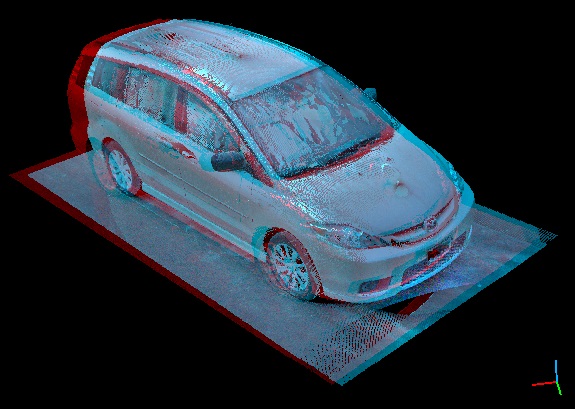
- qAnimation plugin (initiated by 2G Robotics -
http://www.2grobotics.com/) - see wiki
- animation rendering
- can create video files (MPEG, h232, etc. - depending on the installed codecs)
- qFacet plugin (created by BRGM - http://www.brgm.eu) - see wiki
- automatic planar facets (e.g. fracture planes) detection by region growing
- orientation-based classification
- stereogram display
- stereogram based segmentation
- export to SHP and CSV files
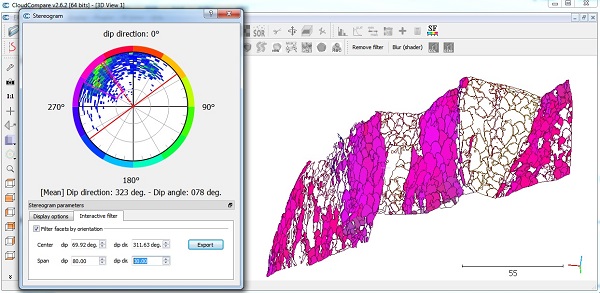
- qGMMReg plugin
- non-rigid registration of clouds (or mesh vertices)
- based on the GMMReg library
- meant to be used on small entities (i.e. a few thousand points)
- Gridded/structured clouds handling
- CC will now remember the structure of gridded clouds (PTX, DP, FARO, etc.)
- see the new 'Scan grid' section of the cloud properties
- this structure can be used when computing normals for instance (see below)
- this information is preserved if multiple gridded clouds are merged, cloned or segmented

- Brand new 'Normal Computation' dialog - see wiki
- grid structures (see above) can now be used in the 'Normal Computation' dialog (they can be used for computation but they are more interesting to orient the normals)
- new 'auto' button for the standard 'octree-based' computation algorithm (if a single cloud is selected). CC will automatically estimate a good local radius for neighbors extraction
- new 'preferred orientation' option: 'Use previous normal' to use the former normal (if any) to orient the new one
- all the orientation options can now be set in the dialog (gridded/preferred/Minimum Spanning Tree)
- no more nagging about using the Minimum Spanning Tree and other questions...
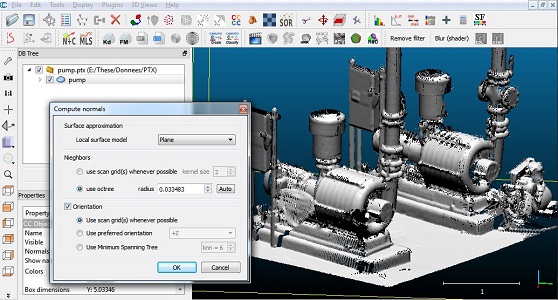
normals oriented with scan grids (PTX, FARO, DP, etc.)
- New method 'Edit > Sensor > TLS/GBL > Compute points
visibility' - see wiki
- if a TLS/GBL sensor is selected and this method called, the user can select any point cloud and CC will classify its points in terms of 'visibility' relatively to the selected sensor
- classes are: VISIBLE / HIDDEN / OUT OF RANGE / OUT OF FIELD OF
VIEW
- New option in the context menu of the DB tree (right click on an item)
- 'Select children by type and/or name' - to select items either by type and/or by name
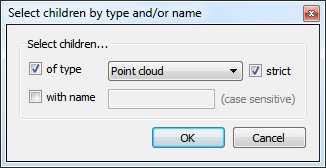
- New shortcuts for 3D views:
- Zoom in (+)
- Zoom out (=)
And here are the enhanced features:
- Rasterize tool - see the updated wiki
- the user can now change the displayed 'layer' (either the height or one of the input cloud SFs)
- the input cloud SFs can now be properly interpolated in empty cells
- the contour lines are now computed on the active layer
- the user can set the default width for the countour lines
- the contour lines can be colored (according to the layer associated scalar field settings)
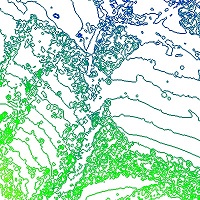
- SOR filter - see the update wiki
- the PCL Statistical Outlier filter (for noise cleaning) has been integrated in CloudCompare
- it can be accessed via 'Tools > Clean > SOR filter'
- its icon has been moved to the main toolbar
- the tool is now accessible through the command line (see below)
- the other noise filtering tool has been renamed ('Tools > Clean > Noise filter')
- Poisson Surface Reconstruction:
- now using PoissonRecon library version 7
- built-in color interpolation (faster & cleaner)
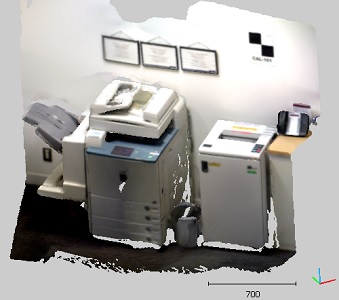
'Poisson' mesh reconstructed from a colored cloud
(as the cloud was structured - DP - the normals where also very clean ;)
- Display:
- CloudCompare now supports 'Level Of Detail' (LoD) display for big clouds
- if enabled, the clouds are now displayed first at a low octree level when moved and are then regularly refined when the user doesn't interact with them
- the user can now specify the minimal number of points and the minimal number of triangles necessary to activate LoD/decimated display

- Segmentation:
- the 'Edit > Crop' and 'Tools > Segmentation > Cross Section' tools can now be applied on triangular meshes
- moreover, the applied cut is clean (i.e. true re-meshing is performed on the edges)
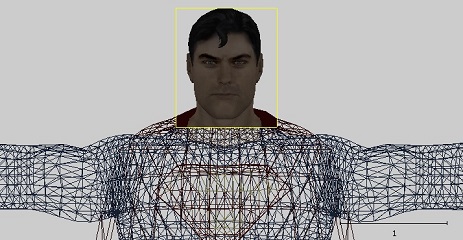
- Histogram dialog:
- new icon 'Export to CSV'
- new icon 'Export to image'
- the SF parameter 'Show NaN values in gray' is now taken into account (i.e. the gray/hidden values won't appear in the histogram if this option is not checked)
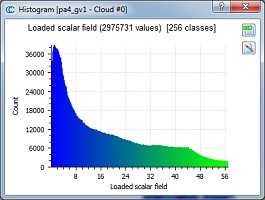
- Command line:
- the 'Cross Section' tool (single or multiple slices extraction) can now be called via the command line (with a dedicated XML parameters file)
- the SOR filter can now be called with via the command line:
- 'SOR' + number of neighbors (knn) + std. dev. multiplier (nSigma)
- the loaded clouds are replaced by their filtered version
- the 'SF Arithmetic' tool can now be called via the command line:
- 'SF_ARITHMETIC' + SF index + operation
- supported operations are: sqrt, pow2, pow3, exp, log, log10, cos, sin, tan, acos, asin, atan, int, inverse)
- new options for the 'ICP' tool:
- 'DATA_SF_AS_WEIGHTS' + SF index (to use the given scalar field of the data entity as weights)
- 'MODEL_SF_AS_WEIGHTS' + SF index (to use the given scalar field of the model entity as weights)
- the 'LAST' option can be used instead of an explicit SF index
- new options 'POP_CLOUDS' and 'POP_MESHES' to remove the last loaded cloud or mesh
- new options for ASCII export:
- 'ADD_HEADER' to add a header with each column's name to the saved file
- 'ADD_PTS_COUNT' to add the number of points at the beginning
of the saved file
- Fine registration (ICP)
- CC will now compute real cloud/mesh distances if the reference/model entity is a mesh
- the registration will be much more accurate
- (in this case the sampling parameter will only be used for the registered/data entity)
- Weighted ICP is now functional
- the user can use the currently active scalar field on the registered and/or the reference clouds as weights. The bigger the weights, the more influence the points will have.
- weights are automatically normalized
- only absolute values are considered
- Initial point selection (when using a final overlap below 80%)
is now much faster
- Distances computation tool:
- the dialog has been slightly updated (simplified)
- the approximate distances and the best octree level don't need to be automatically updated any time a parameter is updated anymore
- C2C:
- if the 'reference' cloud has an associated sensor, the user can now check the new option 'use reference sensor to filter hidden points'.
- this will tell CC to use the sensor information to determine whether the points of the compared cloud were hidden at the time of the reference acquisition (and should therefore be ignored)
- see the forum for a good example of how it works
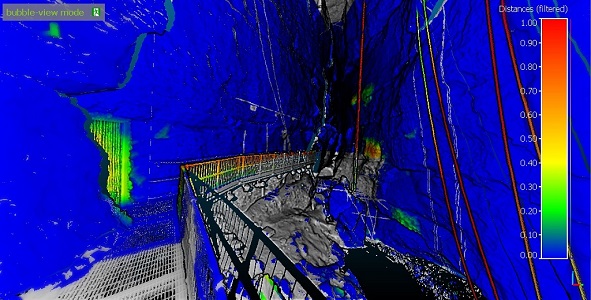
C2C distances filtered based on the reference sensor point of view
- 'Render to file' method:
- rendering zoom is now more properly taken into account when displaying 2D labels
- zoomed text size is estimated in a more accurate way
- the displayed size for the scale was wrong when the zoom was
not 1
- 3D views now recognize the 'pinching' gesture (with 2 fingers) on multi-touch screens (i.e. to zoom in and out)
- If available the version of the Visual Studio compiler and the
version of Qt used to compile CC are now displayed in the 'About' dialog
- PLY files with more than one texture can now be properly opened
- ASCII save dialog:
- the output precision of scalar values can now be set up to 12 (instead of 8)
- note that the internal representation of scalars remains
32-bits floats (i.e. with a relative precision ~10^-7)
- Ransac Shape Detection:
- detected cones are now properly truncated so as to visually fit
the associated subset of points
- Point list picking:
- label names are now preserved (if the user quits the tool, changes the labels name and restart the tool)
- labels title in 3D have now a semi-transparent background
- the point list can now be exported in a text file with 'label
name, x, y, z' on each line
- Profile extraction (both in the Cross Section tool and the Section Extraction tool):
- new 'multi-pass' option to enable/disable the additional passes
where longer edges can be generated (in order to ultimately get a
better fit... or not). It was enabled by default in the previous
version.
- Console:
- multiple lines can be selected (and copied) at once
- Color Scales Manager:
- custom labels can be defined for each color scale (if that's the case then only those labels will be used when displaying the color ramp next to the cloud in the 3D view)
- when the 'relative/absolute' parameter of an existing color scale is modified, the saturation of the scalar fields relying on this scale is now properly updated
- new 'Apply' button to apply the modifications without leaving
the tool dialog
- the SOR and MLS filters of the qPCL plugin (Point Cloud Library wrapper) now preserve the global shift & scale information
- Normals are now internally coded on 32 bytes (instead of 16
bytes) so as to increase the normals (direction) precision (instead of
32K different directions - which is visually sufficient - 2M directions
can now be coded - which is much better for normal-based
computation, such as Dip/Dip direction computation or the new qFacet
plugin)
- Fit Quadric:
- the matrix local quadric coordinate system is now displayed in
the console along with its equation
- qSRA:
- the plugin can now be used directly with a cone or cylinder primitive (in place of a 'profile')
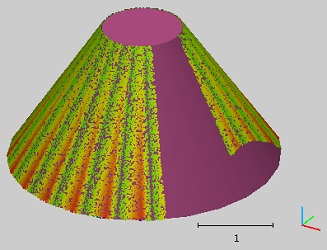
- LAS files:
- the 'time' field of LAS files is now automatically shifted at loading time so as to prevent any loss of accuracy (as this field is originally coded on 64 bits but then stored on 32 bits once loaded)
- the original value of a single point can be queried anytime by spawning a label on this point
- the original value is restored automatically when saving the cloud
And last but not least, here are the dead bugs:
- The point size couldn't be modified in the 3D view of the 'Rasterize' tool
- The 'inverse (1/x)' function of the SF arithmetic tool was not accessible (the integer part was applied instead)
- If only one plugin was loaded (with mulitple methods such as qPCL) then the 'Plugins' menu was staying disabled
- The scale value displayed in 3D views (under the scale bar) was wrong when the zoom of the 'Render to file method was greater than 1
- The 'Apply all' option of the 'Global shift & scale' dialog wasn't taken into account when loading LAS/LAZ files
- The main window could sometimes disappear in the background when the progress bar was appearing (Qt 5 issue)
- Some options of the context menu of the DB tree were incorrectly using the term 'siblings' instead of 'children'
- The VBO was not always updated when the cloud was translated (as a consequence, the clouds were not displayed in the right place)
- While importing a Bundler file, if the images were to be 'kept in memory' but not the keypoints, then CC would crash
- When saving a mesh composed of multiple sub-meshes to OBJ format, the triangles and texture information could be inconsistent
- When merging two or more meshes, material were merged if their name were the same even if the texture or other parameters were different
- When filtering a cloud through the command line (with FILTER_SF), the cloud was not updated in memory if the AUTO_SAVE feature was disabled
- The 'o' keyword in OBJ files was ignored (this could led to missing textures, etc.)
- Registration (either ICP or point-pair based picking) could crash in some particular cases
- qSRA:
- whether the profile origin is absolute or relative was not always taken into account!
- a flat profile (e.g. perfect cylinder) would prevent the plugin from exporting DXF files
- the 'units' field in the DXF export dialog was ignored
- PTX files: the sensor position was overlooked (as it's almost always the same as the scan position... almost ;)
- Section extraction: CC was crashing when extracting section clouds from multiple clouds at the same time
- Command line: when automatically saving a file, CC will now add the suffix after the last point of the origin filename
- qCork was crashing on Windows 8 (Cork also relies on the 'triangle' library ;)
- FBX files: the exported 'specular' component of materials was in fact the 'ambient' component (resulting in a much brighter look)
- In command line mode, the Delaunay command was ignoring the 'AUTO_SAVE OFF' option and was creating a looping hierarchy (potentially causing infinite loops later...)
- OBJ files: when merging multiple models with textures having the same (local) filename, the images could overwrite each other once saved
- Rasterize: saving a raster with the currently displayed scalar field as additioanl layer would make CC crash (+ memory leak fixed)
- Point-pair based alignment: the markers picked on the aligned entity could become very big (or very small) when the scale was to be adjusted and the scale of the aligned entity was very different from the reference one.
- The 'Apply Transformation' tool can now be applied on primitives
And last but not least, you can make donations to the project via'Pledgie':

Enjoy,
CloudCompare Admin
PS: if you can't read properly this message, you can read it here: http://www.cloudcompare.org/release/notes/20151008
- This mailing list is a public mailing list - anyone may join or leave, at any time.
-
This mailing list is announce-only.
To be informed of the last CloudCompare official release
Privacy Policy:
This mailing list is used to keep you and others informed about the last CloudCompare updates. We do not share or sell your information to any third parties.
If you have any question or concerns, please contact us at admin@cloudcompare.org.
 The
The 